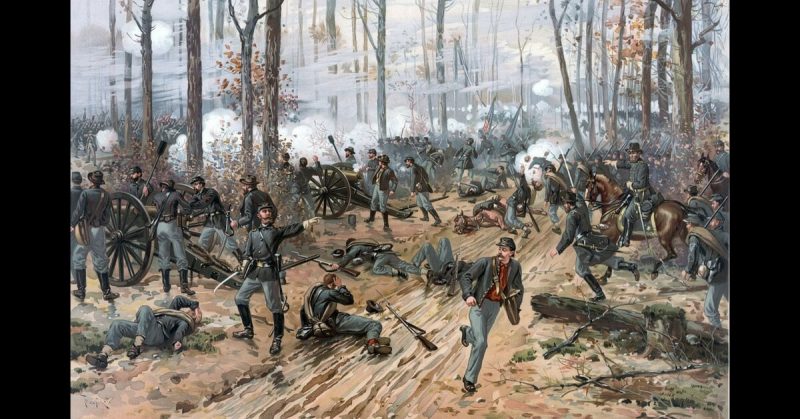Fought on April 6 and 7, 1862, the Battle of Shiloh was one of the most important in the western theater of the American Civil War. It saw unprecedented levels of bloodshed and proved there would be no easy win for either side.
“We Must Do Something”
The Confederate attack at Shiloh was led by General Albert Sidney Johnston and his second-in-command, General Pierre Beauregard.
Johnston was coming under heavy criticism back home. He needed to act decisively to preserve both the Confederacy and his command. Even more eager to attack the Union, Beauregard said: “We must do something or die in the attempt, otherwise, all will be shortly lost.”
They advanced to attack Union forces in Tennessee.
An Aggressive Spirit
Union forces, led by Ulysses S. Grant and Don Carlos Buell, were in an equally aggressive mood. Grant was so focused on his own offensive plans that he gave little regard to what Johnston might do.
Union forces were confident they would be the attackers in any engagement. When they arrived at Pittsburg Landing on the Tennessee River, they did not entrench or arrange a defensive encampment. Grant did not want to rob his men of their aggressive spirit through defensive measures.
“My God, We’re Attacked!”
On the morning of April 6, they were shocked at how wrong they had been.
Before dawn, a Union patrol from General Prentiss’s division encountered Confederate forces advancing through the tangled woods and scrub around Pittsburg Landing. The sound of their fighting retreat toward their camp was the first warning the Union soldiers had.
Men leaped from their beds. General Sherman, hurrying to see what was happening, saw his orderly shot dead beside him. “My God, we’re attacked!” Sherman exclaimed.
Rushing to See the Elephant
Many of the Union troops, including Grant, were camped several miles away. Grant ordered his troops to advance with all speed to the landing, while he rushed there in a dispatch boat.
Along a six-mile front, soldiers engaged in the bloodiest fight of the war so far. Many were fresh recruits. It was their first experience of “seeing the elephant,” army slang for combat.
Reorganization
Amid the tangled terrain, both armies threatened to dissolve into chaos. New recruits on both sides fled the battle in terror. Formations were broken. Johnston and Grant rushed around the lines, trying to assert order.
For Grant, it was about clinging on until more troops arrived and preparing for a last stand if it were needed. For Johnston, it was about pushing forward while he had the edge.
Being so close to the fighting, both men were in danger. In the middle of the afternoon, a bullet hit Johnston in the leg. It severed an artery, and he quickly bled to death.
Prentiss’s Stand
Beauregard, taking over as Confederate commander, pushed the attack, driving the Union flanks back two miles.
In the center, Prentiss gathered the remains of his Union division and parts of two others along a sunken road. Outnumbered four to one, they held out for hours, fending off a dozen Confederate assaults. Finally, the Confederates brought up 62 field guns to pound their position.
An hour before sunset, Prentiss surrendered to the surrounding enemy. Of his 4,500 men, only 2,200 remained.
They had bought Grant the time he needed. The rest of the Union army now held a line along the Pittsburg Landing Ridge.
Ending the Day on a High Note
As evening fell, many officers advised Beauregard to launch a final attack and break the enemy. Others recommended a retreat.
Beauregard did neither. His men were exhausted, disorganized, and in need of rest, but he believed that after resting they could win. He planned to attack again the next day.
On the other side of the field, Grant was also finishing the day on a high note. More troops had arrived under Buell. Grant had the advantage of terrain, which was one of his strengths. By the morning, his forces would outnumber the Confederates. He too planned to attack.
A Long, Wet Night
The armies spent a lousy night in the field. Rain poured down. Thunder and lightning accompanied the man-made roar of artillery, disturbing what sleep the soldiers could get. Thousands of fallen wounded lay in agony in the mud.
The Yankees Attack
At dawn, Grant and Buell attacked. This time, they had the element of surprise, beating Beauregard to the punch. They pushed the disorganized Confederates back for several hours until Beauregard formed a strong line. Then the fierce fighting of the previous day recommended.
Advancing across the field was harrowing even for experienced soldiers. Clusters of dead and wounded men lay across the landscape, having huddled together for warmth in the night.
A Lump of Sugar Waiting to Dissolve
By mid-afternoon, the Confederate troops were exhausted and demoralized. Their impending victory had been snatched away. They were outnumbered and on the retreat. Beauregard’s chief of staff compared them with a lump of sugar soaked through with water, holding its shape but about to dissolve.
Beauregard ordered a retreat. The Union forces did not try to pursue them through the thick mud. They too were exhausted. A brief pursuit the next day resulted only in a desultory skirmish with Confederate cavalry.
The fighting was over for now.
A Disillusioning Fight
With 20,000 casualties, Shiloh was the first battle of the war to see bloodshed on such an enormous scale. It was disillusioning for all involved. The Confederates saw their hopes of a western offensive shattered. The Union discovered that the Confederates in the west would not be easily defeated.
Most of all, thousands of soldiers on both sides saw the elephant for the first time. It was muddy, blood-slicked, and screaming in pain. War, they discovered, was not nobility and drama. It was exhaustion and death.
Sources:
John Keegan (1987), The Mask of Command
James M. McPherson (1988), Battle Cry of Freedom: The American Civil War
